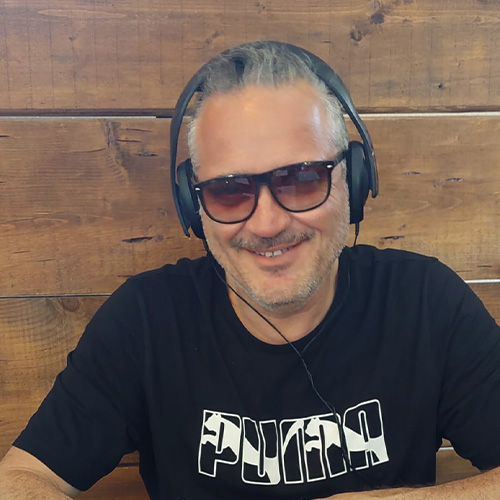

The East Quayside and the lighthouse
The East Quayside and the lighthouse
Riproduci traccia audio
Play audio track
Audio-Track abspielen
The East Quayside and the lighthouse
Trascrizione traccia audio
When the fog surrounds the city, the sound of the foghorn reaches as far as the countryside, all the way to Cesena (some 17 kilometers away).
For those who work at sea it is an alert, for those who live in the countryside the warning that probably, very shortly, a wall of fog will roll inland, to the point of consuming it, like the sea, in a space without volume. You no longer see water, nor earth, nor sky, you are in limbo, you only hear the tone of the foghorn, and a feeling of infinity pervades you.
The entrance to the harbour is marked by two small lights: the green one indicates the way for those who return, the red one for those who are going out to sea. It is here, where the foghorn is located. Its call is long, penetrating, deep, a sound wave that breaks on the buildings, bouncing against the beach bars, the hotels and the skyscraper.
There is a place, far from here, that for centuries was the reference point for fishermen taken unaware by fog and storms: situated in the hills, high above Cesena, in the town of Sogliano sul Rubicone, is the Farneto Church. From there you can see the sea.
Well before the lighthouse was built at the end of the nineteenth century, large fires would be lit around the Church which would guide the boats into port.
Even today, towards the end of the summer, on September 8, there is a procession of fishermen that go to the church, offering fish to the Madonna of Farneto as a sign of thanksgiving, and to ask that those who go to sea are able to find their way back.
The sound of the foghorn can last for whole days and nights. Before today’s navigation technology was available, it was a sound that evoked protection, safety, life, it pointed the way for many. But even today it is still loved by Cesenatico, who feel that it is an integral part of its social fabric, of everyday life, of the sounds of the town.
At this point you can hear the roar of the fishing boat engines as they enter the port at low speed: a rather dull noise, which is followed by the screech of the “cucchèl”, (Coo-kell) the seagulls, who create a white cloud around the boat while fighting to win the scraps that fall into the water when the fishermen rinse the deck after packing their haul away.
In summer, from the end of the harbour you can hear other sounds of Cesenatico: the voices of the bathers, the loudspeakers of the beach bars, the fireworks and the concerts on the beach held at sunrise.
At half past four in the morning the sound engineer and the musicians will arrive for a sound check on a stage that has been constructed during the night. The concert starts at six am, but people start to arrive at half past five, with duvets and towels to spread out on the sand. Ten minutes before the concert begins, when everything is ready, I turn to the sea, as smooth as oil.
The sun is beginning to rise, and a small, almost unnoticeable wave breaks on the shoreline.
I play a wind instrument and so I concentrate on deep and conscious breathing to fill my lungs with oxygen. I block out all other noise other than the harmony that surrounds me – it acts as a tuning fork before I start to play.
Audio Track transcription
When the fog surrounds the city, the sound of the foghorn reaches as far as the countryside, all the way to Cesena (some 17 kilometers away).
For those who work at sea it is an alert, for those who live in the countryside the warning that probably, very shortly, a wall of fog will roll inland, to the point of consuming it, like the sea, in a space without volume. You no longer see water, nor earth, nor sky, you are in limbo, you only hear the tone of the foghorn, and a feeling of infinity pervades you.
The entrance to the harbour is marked by two small lights: the green one indicates the way for those who return, the red one for those who are going out to sea. It is here, where the foghorn is located. Its call is long, penetrating, deep, a sound wave that breaks on the buildings, bouncing against the beach bars, the hotels and the skyscraper.
There is a place, far from here, that for centuries was the reference point for fishermen taken unaware by fog and storms: situated in the hills, high above Cesena, in the town of Sogliano sul Rubicone, is the Farneto Church. From there you can see the sea.
Well before the lighthouse was built at the end of the nineteenth century, large fires would be lit around the Church which would guide the boats into port.
Even today, towards the end of the summer, on September 8, there is a procession of fishermen that go to the church, offering fish to the Madonna of Farneto as a sign of thanksgiving, and to ask that those who go to sea are able to find their way back.
The sound of the foghorn can last for whole days and nights. Before today’s navigation technology was available, it was a sound that evoked protection, safety, life, it pointed the way for many. But even today it is still loved by Cesenatico, who feel that it is an integral part of its social fabric, of everyday life, of the sounds of the town.
At this point you can hear the roar of the fishing boat engines as they enter the port at low speed: a rather dull noise, which is followed by the screech of the “cucchèl”, (Coo-kell) the seagulls, who create a white cloud around the boat while fighting to win the scraps that fall into the water when the fishermen rinse the deck after packing their haul away.
In summer, from the end of the harbour you can hear other sounds of Cesenatico: the voices of the bathers, the loudspeakers of the beach bars, the fireworks and the concerts on the beach held at sunrise.
At half past four in the morning the sound engineer and the musicians will arrive for a sound check on a stage that has been constructed during the night. The concert starts at six am, but people start to arrive at half past five, with duvets and towels to spread out on the sand. Ten minutes before the concert begins, when everything is ready, I turn to the sea, as smooth as oil.
The sun is beginning to rise, and a small, almost unnoticeable wave breaks on the shoreline.
I play a wind instrument and so I concentrate on deep and conscious breathing to fill my lungs with oxygen. I block out all other noise other than the harmony that surrounds me – it acts as a tuning fork before I start to play.
Audiotrack-Text
When the fog surrounds the city, the sound of the foghorn reaches as far as the countryside, all the way to Cesena (some 17 kilometers away).
For those who work at sea it is an alert, for those who live in the countryside the warning that probably, very shortly, a wall of fog will roll inland, to the point of consuming it, like the sea, in a space without volume. You no longer see water, nor earth, nor sky, you are in limbo, you only hear the tone of the foghorn, and a feeling of infinity pervades you.
The entrance to the harbour is marked by two small lights: the green one indicates the way for those who return, the red one for those who are going out to sea. It is here, where the foghorn is located. Its call is long, penetrating, deep, a sound wave that breaks on the buildings, bouncing against the beach bars, the hotels and the skyscraper.
There is a place, far from here, that for centuries was the reference point for fishermen taken unaware by fog and storms: situated in the hills, high above Cesena, in the town of Sogliano sul Rubicone, is the Farneto Church. From there you can see the sea.
Well before the lighthouse was built at the end of the nineteenth century, large fires would be lit around the Church which would guide the boats into port.
Even today, towards the end of the summer, on September 8, there is a procession of fishermen that go to the church, offering fish to the Madonna of Farneto as a sign of thanksgiving, and to ask that those who go to sea are able to find their way back.
The sound of the foghorn can last for whole days and nights. Before today’s navigation technology was available, it was a sound that evoked protection, safety, life, it pointed the way for many. But even today it is still loved by Cesenatico, who feel that it is an integral part of its social fabric, of everyday life, of the sounds of the town.
At this point you can hear the roar of the fishing boat engines as they enter the port at low speed: a rather dull noise, which is followed by the screech of the “cucchèl”, (Coo-kell) the seagulls, who create a white cloud around the boat while fighting to win the scraps that fall into the water when the fishermen rinse the deck after packing their haul away.
In summer, from the end of the harbour you can hear other sounds of Cesenatico: the voices of the bathers, the loudspeakers of the beach bars, the fireworks and the concerts on the beach held at sunrise.
At half past four in the morning the sound engineer and the musicians will arrive for a sound check on a stage that has been constructed during the night. The concert starts at six am, but people start to arrive at half past five, with duvets and towels to spread out on the sand. Ten minutes before the concert begins, when everything is ready, I turn to the sea, as smooth as oil.
The sun is beginning to rise, and a small, almost unnoticeable wave breaks on the shoreline.
I play a wind instrument and so I concentrate on deep and conscious breathing to fill my lungs with oxygen. I block out all other noise other than the harmony that surrounds me – it acts as a tuning fork before I start to play.
Narrato da
Narrated by
Mehr Infos



